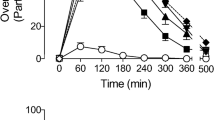Abstract
This study addressed the commonly held, but seldom tested, notion that faster rates of increase of drug effects are associated with more positive subjective effects. Sodium pentobarbital was administered to normal healthy volunteers in either a single oral dose or in a series of divided, cumulating doses, and subjective responses were monitored. Twelve subjects participated in three weekly sessions, during which they received capsules containing placebo, 150 mg pentobarbital in a single dose (SIN) or 180 mg pentobarbital administered in six divided doses (DIV) of 30 mg every 30 min. Doses of pentobarbital in the SIN and DIV were selected to produce similar peak plasma levels. Blood samples were obtained at regular intervals for plasma drug level determinations, and throughout the session subjects completed self-report mood questionnaires (e.g., Profile of Mood States, visual analog ratings of drug liking and drug “high”) and psychomotor performance tests (e.g., Digit Symbol Substitution Test). As expected, the SIN and DIV conditions yielded similar peak levels of pentobarbital, but the peak was attained more rapidly in the SIN condition. Despite the similarity in peak plasma levels, subjects reached greater peaks in ratings of “high” and wanted more of the drug when they were in the SIN condition. On an end-of-session liking questionnaire they also reported significantly greater liking of the drug in the SIN condition. On other measures of drug effects (e.g., sedation and psychomotor impairment) no significant differences were observed between the conditions. Thus, the rate of increase of the drug's effects specifically influenced subjects' ratings on subjective measures (e.g., “high” and liking) that may be associated with risk for abuse. The results have implications for the relative abuse liability of different formulations of psychoactive drugs.
Similar content being viewed by others
References
Ambre J, Belknap S, Nelson J, Ruo T, Atkinson R (1988) Acute tolerance to cocaine in humans. Clin Pharmacol Ther 44:1–8
American Psychiatric Association (1987) Diagnostic and statistical manual of mental disorders, 3rd edn, revised. Washington, DC
Balster RL, Schuster CR (1973) Fixed-interval schedule of cocaine reinforcement: Effect of dose and infusion duration. J Exp Anal Behav 1:67–71
Busto U, Sellers EM, Kaplan HL, Thiessen JJ (1990) Development of experimental pharmacokinetic pharmacodynamic approaches to assess abuse liability of drugs. Clin Pharmacol Ther 47:137
de Wit H, Uhlenhuth EH, Pierri J, Johanson CE (1984) Preference for pentobarbital and diazepam in normal volunteer subjects. Fed Proc 43:931
de Wit H, Pierri J, Johanson CE (1989) Reinforcing and subjective effects of diazepam in nondrug-abusing volunteers. Pharmacol Biochem Behav 33:205–213
Derogatis L (1983) SCL-90-R Manual-II. Clinical Psychometric Research, Towson, MD
Dole VP, Nyswander ME, Kreek MJ (1966) Narcotic blockade. Arch Int Med 118:304–309
Ellinwood EH Jr, Linnoila M, Easler ME, Molter DW (1983) Profile of acute tolerance to three sedative anxiolytics. Psychopharmacology 79:137–141
Fischman MW, Schuster CR (1984) Injection duration of cocaine in humans. Fed Proc 43
Ghoneim MD, Mewaldt SP (1990) Benzodiazepines and human memory: a review. Anesthesiology 72:926–938
Goldstein A, Aronow L (1960) The durations of action of thiopental and pentobarbital. J Pharmacol Exp Ther 128:1
Greenblatt DJ, Shader RI, Harmatz JS, Franke K, Koch-Weser J (1977) Absorption rate, blood concentrations, and early response to oral chlordiazepoxide. Am J Psychiatry 134:559–562
Greenblatt DJ, Shader RI, Divoll M, Harmatz JS (1981) Benzodiazepines: a summary of pharmacokinetic properties. Br J Clin Pharmacol 11 [suppl]:1s-6s
Griffiths RR, McLeod DR, Bigelow GE, Liebson IA, Roache JD (1984a) Relative abuse liability of diazepam and oxazepam: behavioral and subjective dose effects. Psychopharmacology 84:147–154
Griffiths RR, McLeod DR, Bigelow GE, Liebson IA, Roache JD, Nowowieski P (1984b) Comparison of diazepam and oxazepam: preference, liking, and extent of abuse. J Pharmacol Exp Ther 229:501–508
Jasinski DR, Griffith JD, Pevnick J, Gorodetzky C, Cone E, Kay D (1978) Progress report from the Clinical Pharmacology section of the NIDA Addiction Research Center. In: Problems of drug dependence 1977. NIDA Res Monograph, pp 133–168
Johanson CE, Uhlenhuth EH (1980) Drug preference and mood in humans: diazepam. Psychopharmacology 71:269–273
Martin WR, Sloan JW, Sapira JD, Jasinski DR (1971) Physiologic, subjective and behavioral effects of amphetamine, methamphetamine, ephedrine, phenmetrazine and methylphenidate in man. Clin Pharmacol Ther 12:245–258
McLeod DR, Hoehn-Saric R, Labib AS, Greenblatt DJ (1988) Six weeks of diazepam treatment in normal women. J Clin Psychopharmacol 8:83–99
McNair D, Lorr M, Droppleman L (1971) Profile of mood states (manual). Educational and Industrial Testing Service, San Diego
Parrott AC, Hindmarch I (1980) The Leeds Sleep Evaluation Questionnaire in psychopharmacological investigations — a review. Psychopharmacology 71:173–179
Paulson OB, Gyory A, Hertz MM (1982) Blood-brain barrier transfer and cerebral uptake of antiepileptic drugs. Clin Pharmacol Ther 32:466–477
Pratt WB, Taylor P (1990) Principles of drug action, 3rd edn. Churchill Livingston, New York
Russell MAH, Feyerabend C (1978) Cigarette smoking: a dependence on high-nicotine boli. Drug Metab Rev 8:29–57
Salonen M, Aantaa E, Aaltonen L, Hovi-Viander M, Kanto J (1986) A comparison of the soft gelatin capsule and the tablet form of temazepam. Acta Pharmacol Toxicol 58:49–54
Smith RB, Dittert LW, Griffen WO, Doluisio JT (1973) Pharmacokinetics of pentobarbital after intravenous and oral administration. Pharmacokinet Biopharm 1:5–16
Wechsler D (1958) The measure and appraisal of adult intelligence. Williams and Wilkins, Baltimore
Author information
Authors and Affiliations
Rights and permissions
About this article
Cite this article
de Wit, H., Bodker, B. & Ambre, J. Rate of increase of plasma drug level influences subjective response in humans. Psychopharmacology 107, 352–358 (1992). https://doi.org/10.1007/BF02245161
Received:
Revised:
Issue Date:
DOI: https://doi.org/10.1007/BF02245161




